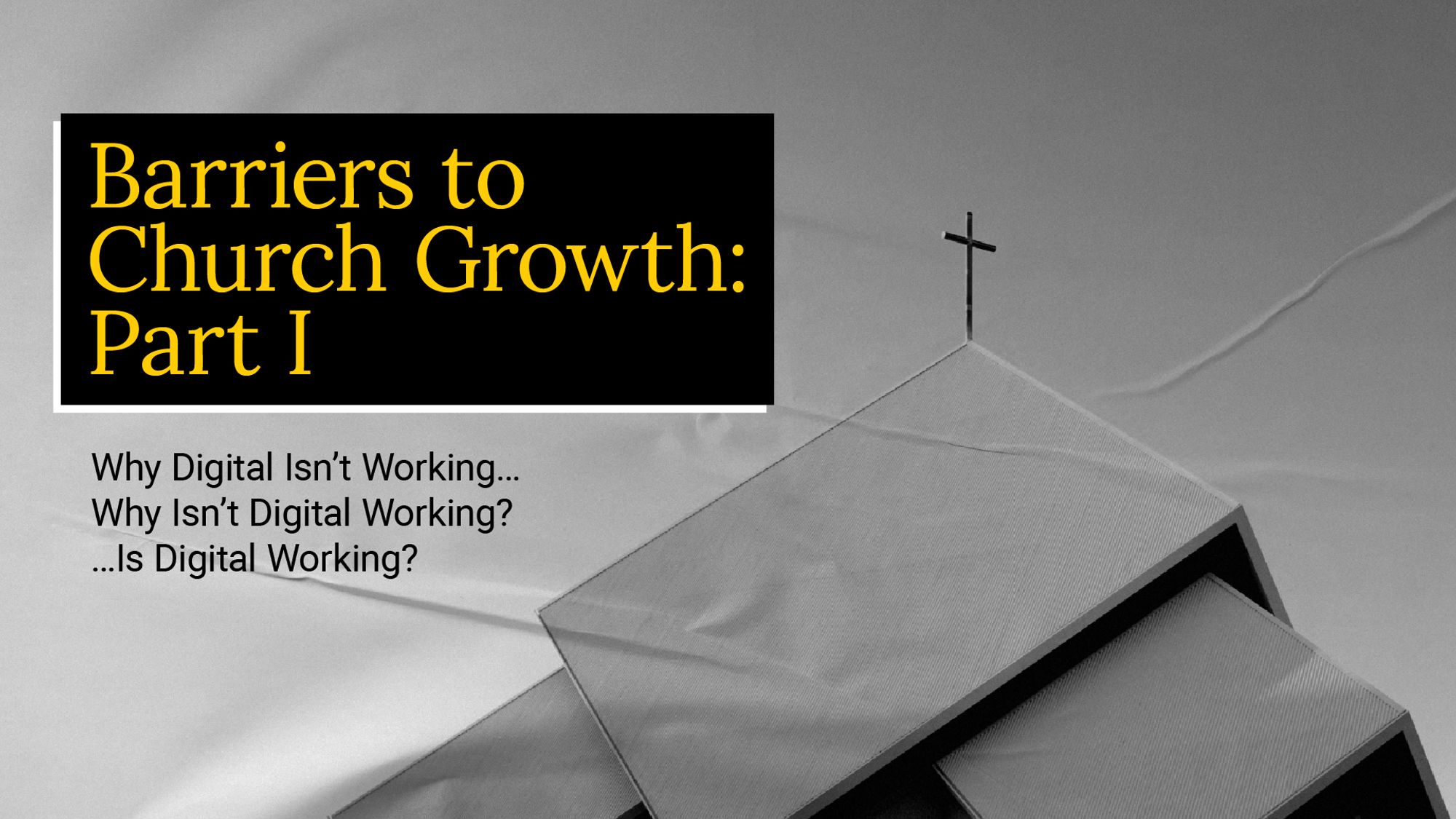
For my church, Sandals Church, the basic pivot to deeper digital church innovation was abrupt, around March of 2020, but not entirely revolutionary. We had been working on the digital front for some time, and this new fuel was well-received and welcomed.
The question in the last year, though, has become whether anything had really materially changed coming out of the initial digital momentum burst that Covid created. And the answer is a resounding YES — even if the evidence takes a bit of excavating.
Pandemic shifting and digital transformation: an inflection point
Our church is functioning much differently than it did five years ago.
So, what happened to our digital ministry revolution? Are we getting that new digital church era the Pandemic promised?
Whether you’re a senior leader earnestly reaching to embrace change and innovation or you’re the lone ranger of the online campus that was chaotically formed in the throes of the Pandemic, you may now find yourself asking these questions. Regardless of whether you’re still hopeful for something new or you love leaning on the comfort of familiarity and stability; the answers bear exploring as we emerge from the market disruption.
So let's ask the question, “Are we seeing the expected inflection point in hybrid ministry?” If not, why? If so, how do we accelerate it?
I’ll take a stab at answering the question through the lens of a church that has lived on the leading edge since before the Pandemic. Hang on with me for a second, this is going to require some numbers.
Coming off the COVID bump, in 2023, we doubled both non-sermon content views as well as sermon views — without sacrificing watch time. That growth included a 400% increase in first-time viewers and a doubling of our weekly engagements.
With focused formational efforts, the digital audience began to join the work, and to give. After a 4X increase over the Pandemic, giving increased by another 20%. Our digital “Solomon’s colonnade” (to borrow from Tim Keller) grew and formed our audience. Then many of them dipped their toe into our live experiences (over 14,000 that we could track) which was a 30% increase over 2022. They were met with meaningful experiences and community they just can’t get from Joe Rogan.
So what did they do? They moved their giving from the online campus to their local campus by the droves.
Once we dug in, we discovered that the online campus generated more new giving for the in-person campuses than all of the satellites combined. Meeting people where they are digitally, earning a voice with them, and then inviting them deeper has proven to work.
In January 2024, our in-person attendance was up over 20%, and digital engagement shows no signs of slowing. Our church is working differently, and it’s a huge win.
We’re hearing similar stories from others who were ahead of us going into 2020 and have emerged with similarly stark hybrid ministry results. Curiosity begins digitally. Formation happens digitally. Both bolster real-life engagement.
Hybrid church works.
So, if that’s not the case for your church and you’re hoping for fresh movement, what may be standing in your way? Whether you’re leading up, leading down, or trying to bring some peers along, you may now be facing some barriers beyond the tactical, technical, or strategic challenges of digital church.
I pray you tackle these barriers because we need your church to succeed in reaching the lost. We need your leadership and your voice.

Barrier 1: There’s real heartache in the pivot
I’m a car guy. I love watching and learning from the industry and the cars they make. (And yes, the BMW E39 M5 was the greatest vehicle ever made.)
When Elon Musk dropped the first production Tesla in 2012, the Model S, he instantly forced the global industry into a pivot they’ve been working through to this day. While the Model S had an incredibly small market share in 2012 and wasn’t going to instantly make gasoline engines obsolete, it did force car manufacturers to begin working towards a future where they might eventually be obsolete.
It was a battle of dual imperatives: how do we continue doing what pays the bills today while preparing for a future where demand may shift to entirely new and different segments?
That is what the Pandemic did to the world — including the church. We were unexpectedly and suddenly forced into a pivot.
When a basketball player pivots, they aren’t making an adjustment. They’re making a directional change. It isn’t incremental. Similarly, the pivots we had to make with shopping… work… education… were not small.
There’s always heartache when you’re suddenly forced into significant change. It was not different for our churches.
For some, this change represents opportunity, and we love opportunity. It involves vision and growth and is exciting. But that’s only for some. For many inside your church, particularly your staff and volunteers, “their thing” and “our thing” suddenly and unexpectedly became less aligned.
As an example, in a research study published by OneHope, only 1% of parents want family ministry to go back to what it was pre-pandemic. Our campus pastors no longer needed to show up to their campus. Our worship leaders couldn’t lead worship. Many congregants were fearful of meeting in small groups, leaving their leaders in empty living rooms. Growth began coming from this online world most didn’t fully understand…
The nice fit many enjoyed and the security they felt knowing the gift they had to offer fit well with the ministry work that was needed suddenly took a gut punch, along with the rest of life. It creates a tremendous sense of loss in a sea of loss. And we know from Ronald Heifetz that “people don’t resist change; they resist loss.”
When this level of loss is met with uncomfortable, unfamiliar changes that fight against our nostalgia and preferences, we become, rightly, heartbroken. We find ourselves at an all-time low of resilience and hope. To say otherwise, following the last few years, is self-deception.
That is where leadership comes in. When leading through fear, leading in the dark, to care for and unify the team, you must re-win their hearts. Great technology and a great plan won’t do.
There’s real, meaningful heartache in the pivot. It’s a reality every leader must face. But it isn’t a hopeless one. Stay tuned for barriers two and three in part two of this article, before we explore the key components that can break through these barriers and help you handle your ministry’s inflection point with grace and success.
Buckle up. We’ve got a lot to cover.
About the Author:
Brian Chelette is an Executive Director for Sandals Church in Southern California. Sandals Church is multi-site with 13 campuses and a broad digital footprint. Brian has the honor of leading the People, Finance, Technology, and Digital Reach teams. He has been part of Sandals Church since 1998, served on the Board of Directors, and has been on staff since 2015. In addition to his role with Sandals Church, Brian serves as a Trustee for California Baptist University. Prior to vocational ministry, Brian was a business owner in Riverside, CA. Brian holds a bachelor's degree from USC and an MBA from Pepperdine.
- Buildings and Finance Insights (74)
- Ministry Insights (71)
- Organizational Insights (62)
- Church Growth (59)
- Leadership (48)
- Buildings and Finance (37)
- Facility Strategy (33)
- Financial Strategy (29)
- Digital Engagement (28)
- Organizational Clarity and Strategy (28)
- Featured Insight - Buildings and Finance (23)
- Multisite (21)
- Digital Engagement Insights (19)
- Buildings That Fund Ministry (17)
- Media (17)
- Featured Insight - Buildings That Fund Ministry (15)
- Church Debt (12)
- Ministry Growth (12)
- Hiring (6)
- Strategy (5)
- Insight FEATURED (4)
- Ministry Strategy (4)
- Church Mergers (3)
- Digital Strategy (3)
- Featured Insight - Multisite (3)
- Merger Insights (3)
- Clarity (2)
- Consultants (2)
- Data Analysis and Reporting (2)
- Featured Insight - Digital Engagement (2)
- Ministry Solutions Group (2)
- Organizational Leadership (2)
- Clear Path Forward (1)
- Consultants - Ministry Strategy (1)
- Featured Insight - Project Financing (1)
- Featured Insight - Succession Planning (1)
- Ministry Solutions Group Team (1)
- Succession Insights (1)

 Brian Chelette
Brian Chelette
Thoughts or insights? We'd love to read them. Please share your insights below.